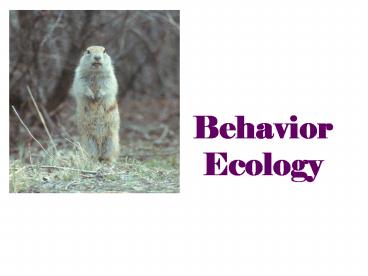Behavior Ecology - PowerPoint PPT Presentation
1 / 28
Title:
Behavior Ecology
Description:
Behavior Ecology. Behavioral Ecologist distinguish between ... Because it is high in calories which are the stuff the body needs to function ... Agonistic ... – PowerPoint PPT presentation
Number of Views:24
Avg rating:3.0/5.0
Title: Behavior Ecology
1
Behavior Ecology
2
Behavioral Ecologist distinguish between
proximate and ultimate causes of behavior.
- Why do we like junk food?
- Because it tastes good (proximate cause)
- Because it is high in calories which are the
stuff the body needs to function (ultimate cause) - These are different levels of explanation
3
2 Fundamental Levels of Analysis
- Proximate
- Causes of the behavior are the how questions.
- Includes effects of heredity on behavior,
genetic-environmental interactions, and
sensory-motor mechanisms. - Ultimate
- Causes of behavior are why questions.
- Include studies of the origin of the behavior,
its change over time, the utility of the
behavior in terms of reproductive success.
4
- Four Questions
- What are the mechanisms that
- cause behavior?
- What is the developmental trajectory?
- What is the survival value?
- How did it evolve?
- A possible additional questionWhat are the
personal experiences of the organism?
5
- Two characteristics that look the same can arise
in two different ways - Homologycommon decent, e.g., the hand of a chimp
and the hand of a human. - Analogyconvergent evolution e.g., wings.
6
Behavior
- What an animal does and how it does it.
- Result of genetic and environmental factors.
7
Behavior Ecology
- Scientific field of study that looks how behavior
is controlled and how it develops, evolves,
contributes to survival and reproductive success.
8
Ethology
- Study of animal behavior in its natural setting.
9
Innate Behaviors
- Developmentally fixed.
- A fixed action pattern is a sequence of innate
behaviors that is largely unchangeable usually
carried to completion once it is initiated. - Fixed action patterns are triggered by sign
stimuli.
10
Imprinting
- A combination of learned and innate components
- limited to a sensitive period in an organisms
life - generally irreversible
11
Many Behaviors Have a Strong Genetic Component
12
KinesisSimple change in activity in response to
a stimulus
Kinesis, like taxis, is a movement or activity of
a cell or an organism in response to a stimulus.
However, unlike taxis, the response to the
stimulus provided (such as humidity, light or
temperature) is non-directional. The two main
types Orthokinesis in which the speed of
movement of the individual is dependent upon the
intensity of the stimulus. Take, for example, the
locomotion of a woodlouse in relation to
temperature. With increased humidity there is an
increase in the percentage time that the
woodlouse will remain stationary. Klinokinesis
in which the frequency or rate of turning is
proportional to stimulus intensity. Both
orthokinesis and klinokineses result in
aggregations. However, it must be noted that the
stimulus does not act to attract or repel
individuals. The same prefixes used with "taxis"
can be applied to kineses
13
Taxis
- An automatic movement toward or away from a
stimulus. - Negative
- Positive
14
Signal
- Behavior that causes a change in a behavior of
another individual. - Pheromones are chemicals signals that are emitted
by animals.
15
Environments, interacting with an animals
genetic makeup, influences the development of
behaviors.
16
Learning
- Modification of behavior based on specific
experiences.
17
Habituation
- Loss of responsiveness to stimuli that convey
little or no information. - Simple Form of Learning
18
Cognitive Map
- Internal representation of spatial relationships
among objects in an animals surroundings.
19
Associative learning
- The ability of many animals to associate one
feature of their environment with another
feature. - Classical Conditioning Learning to associate
certain stimuli with reward or punishment. - Operant Conditioning Occurs as an animal learns
to associate one of its behaviors with a reward
or a punishment.
20
Cognition
- The ability of an animals nervous system to
perceive, store, process, and use information
from sensory receptors.
21
Natural Selection Favors Behavior that Increase
Survival and Reproductive Success
22
Foraging Behavior
- Includes not only eating, but also mechanisms
used in searching for, recognizing, and capturing
food. - It represents a compromise between the benefits
of nutrition and the cost of obtaining food.
23
Mating Behavior Mate Choice
- Seeking or Attracting a Mate
- Selecting a Mate
- Competing for a Mate
24
Agonistic Behaviors
- Ritualized contests that determine which
competitor gains access to a resource, such as
food or mates.
25
Concept of Inclusive Fitness
- Accounts for most Altruistic Behavior
26
Altruism
- Occurs when animals behave in ways that reduce
their individual fitness, but increase the
fitness of other individuals in the population.
27
Inclusive Fitness
- Total effect of an individual has on
proliferating its genes by producing its own
offspring. - Kin Selection Natural selection that favors
the kind of altruistic behavior by enhancing
reproductive success of its relatives.
28
Social Learning
- Learning through observing others.
- Sociobiology Applies evolutionary theory to the
study of social behaviors.































